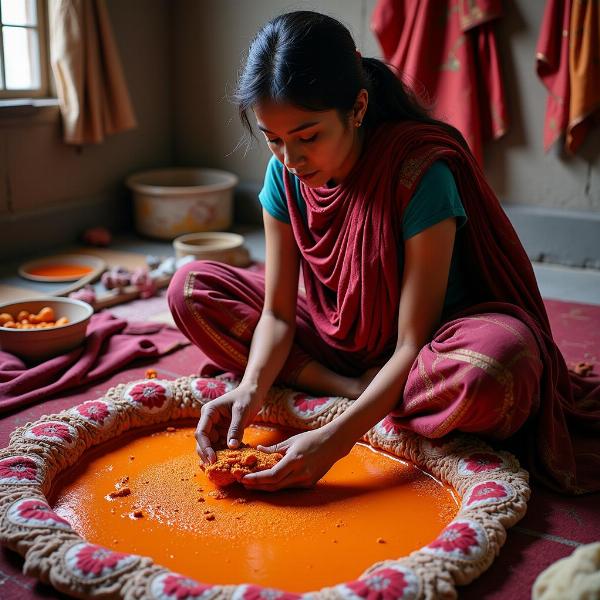Understanding the meaning and cultural significance of “dyer” in Hindi provides valuable insights into Indian traditions, occupations, and artistic expressions. “Dyer,” translated as “रंगरेज़” (rangrez) in Hindi, encompasses more than just the act of coloring fabrics. It represents a rich history intertwined with craftsmanship, community, and cultural identity.
Understanding the Word “Rangrez” (Dyer)
The Hindi word “rangrez” (रंगरेज़) is derived from two words: “rang” (रंग), meaning color, and “rez” (रेज़), stemming from the Persian word “riz,” signifying pouring or sprinkling. This etymology beautifully encapsulates the dyer’s craft – the skillful application of colors onto fabrics. Beyond the literal meaning, “rangrez” often symbolizes vibrancy, artistry, and the transformation of the mundane into something beautiful. What comes to mind when you think of a dyer? Perhaps the vibrant hues of a Holi celebration or the intricate patterns of a traditional sari?
 A traditional Indian dyer at work
A traditional Indian dyer at work
The Dyer’s Role in Indian Society
Historically, dyers held a prominent place in Indian society. They were not merely artisans but integral members of the community, contributing to religious ceremonies, festivals, and everyday life. Their skills were passed down through generations, preserving traditional techniques and knowledge. From dyeing fabrics for weddings and festivals to creating colorful garments for everyday wear, dyers played a crucial role in adding color and vibrancy to people’s lives.
The Art of Natural Dyeing
Traditional Indian dyeing methods often relied on natural sources like plants, flowers, and minerals. These natural dyes, while requiring more intricate processes, produced unique and long-lasting colors. Indigo, turmeric, and madder root were some of the commonly used natural dyes, each contributing its distinct hue to the rich tapestry of Indian textiles. Imagine the expertise required to extract these colors and apply them with precision!
Modern Dyeing Practices in India
While synthetic dyes have become prevalent in modern times, the tradition of natural dyeing is experiencing a revival. Many artisans are returning to these traditional methods, recognizing the ecological benefits and the unique aesthetic qualities of natural dyes. This resurgence reflects a growing appreciation for sustainable practices and the cultural heritage associated with natural dyeing. What are your thoughts on this revival?
The Future of Dyeing in India
The future of dyeing in India likely lies in a blend of tradition and innovation. While synthetic dyes offer efficiency and a wider range of colors, the growing demand for sustainable and eco-friendly practices is fueling the resurgence of natural dyeing. This dynamic interplay between tradition and modernity will likely shape the future of this vibrant craft.
Conclusion
The word “dyer,” or “rangrez” in Hindi, signifies more than just a profession; it represents a rich cultural heritage, artistic skill, and a deep connection to color and tradition. From ancient dyeing techniques using natural sources to the modern applications of synthetic dyes, the art of dyeing continues to evolve while retaining its significance in Indian society.
FAQ
- What is the literal meaning of “rangrez” in Hindi? The word “rangrez” is a combination of “rang” (color) and “rez” (pouring/sprinkling), signifying the act of applying color to fabrics.
- What are some traditional natural dyes used in India? Traditional Indian dyers commonly used indigo, turmeric, madder root, and various other plant-based materials for dyeing.
- Why is natural dyeing experiencing a revival in India? The resurgence of natural dyeing is driven by a growing awareness of sustainable practices and an appreciation for the unique qualities of natural colors.
- What is the significance of dyers in Indian culture? Dyers have historically held a prominent position in Indian society, contributing to festivals, ceremonies, and the creation of vibrant textiles for everyday life.
- What does the future hold for the dyeing industry in India? The future likely involves a blend of traditional and modern techniques, balancing efficiency with sustainability.
- Where can I find traditional hand-dyed textiles in India? Many local markets and craft centers across India offer a wide selection of hand-dyed textiles.
- Are natural dyes more expensive than synthetic dyes? Generally, natural dyes and the processes involved can be more expensive than synthetic dyes.
Related Articles
Meaning-Hindi.in is your trusted partner for professional Hindi translation services. We offer a wide range of services, including business and commercial document translation, certified and legal document translation, technical and user manual translation, website and localization services, educational and academic translation, and express translation services. We are committed to providing accurate, culturally sensitive, and high-quality translations. Contact us today for your translation needs! Email: [email protected], Phone: +91 11-4502-7584. Meaning-Hindi.in is here to help bridge the language gap and connect you with the world.